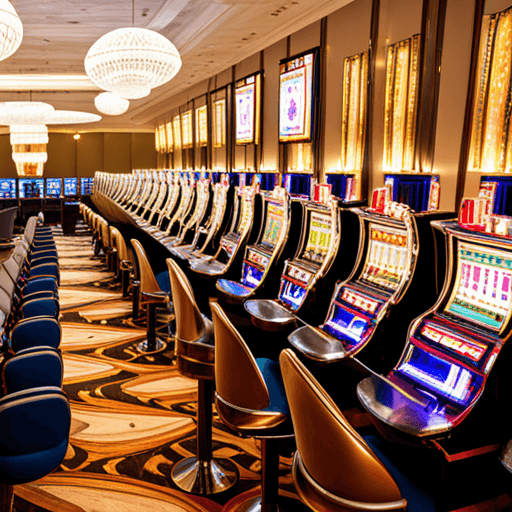
In a dynamic and stimulating world of casinos, where fortune and strategy intertwine, hues and aesthetic play a key role in drawing in gamblers. From the moment players step into a casino or access a gaming platform, they are immersed in a sightly feast that grabs their attention and lures them to discover further. Vivid colors, captivating graphics, and creative layouts are meticulously crafted to create an environment of thrill and anticipation, ultimately enhancing the gaming experience.
While players move through the ever-changing landscape of casino games, they come across a variety of designs that not only serve aesthetic purposes but also influence emotions and decision-making. Hues like scarlet and yellow symbolize riches and fortune, while soothing navy and greens can create a more tranquil environment. Grasping how these elements function together enables casinos to create an inviting and energizing atmosphere that encourages players to engage with the games, spend additional time at the tables, and boost their overall enjoyment.
The Psychology of Color in Gambling Games
Hue plays a critical role in the development of gaming experiences, shaping players’ feelings and responses. Lively and striking hues, such as scarlet and yellow, are often used to ignite thrill and draw attention. These colors create a feeling immediacy and vitality, encouraging players to involve themselves more eagerly with the experience. By intentionally selecting colors, creators aim to inspire emotions of satisfaction and anticipation, which can enhance the overall gaming experience.
Distinct hues also have psychological meanings that can impact how players perceive their odds of winning. BET88 For instance, lime is commonly associated with luck and prosperity, making it a frequent choice in games like roulette and poker setups. This connection can result players to feel more optimistic and assured in their gameplay, ultimately encouraging them to wager more. Understanding these associations allows game designers to create environments that enhance player enjoyment and loyalty.
Furthermore, the interface of gaming interfaces often utilizes gradients and opposing shades to direct players’ responses. For case, winning results may be accentuated with striking, differing colors, creating a visual reward. This technique strengthens successful results and encourages repeated participation. By exploiting color psychology, gaming venues can develop activities that not only captivate gamblers but also maintain them involved and invested in their play experience.
Design Elements that Attract Gamers
The visual appeal of casino games is primarily influenced by the use of bold colors. Bright and striking colors are strategically chosen to create an appealing atmosphere that captures attention. For instance, crimson and golds often signify luck and wealth, which is why they are common in the color schemes of gaming machines and game surfaces. These colors not only draw players in, but they also evoke emotions associated with thrill and expectation, enhancing the total gaming experience.
In parallel to color, the design and organization of gambling games play a crucial role in captivating players. Games are designed to be intuitive, ensuring that players can quickly understand the rules and mechanics. Accessible interfaces, along with captivating graphics and motion, help maintain player interest and promote extended play sessions. The tactile elements, such as the feel of the controls and the audio of the games, also add to a holistic sensory experience that keeps players engaged.
Finally, conceptual elements in game design can greatly influence gaming decisions. Many gambling games are inspired by popular culture, myths, or adventure themes, featuring symbols and characters that resonate with players. These themes create a sense of engagement and connection, making each game feel unique. When players feel a bond to the concept, they are more likely to opt for that game over others, leading to increased participation and excitement within the casino environment.
Case Studies: Notable Casino Slot Designs
One key example of effective gambling game design is the acclaimed slot machine series based around blockbuster movies. Games such as those based on the Wizard of Oz and Game of Thrones utilize dynamic colors and top-notch graphics to engage players in recognizable narratives. The application of dynamic visuals and engaging sound effects captures the attention of players, creating an affective connection to the theme. This strategy not just fosters longer play but also enhances the overall gaming experience, leading to increased player retention.
Another notable case is the use of color psychology in table games like blackjack and the wheel. Casinos often design these games with rich reds and greens, colors traditionally linked with luck and wealth. For instance, the green felt on a blackjack table provides a calming effect, while the crimson accents in roulette invite excitement. This deliberate use of color helps to foster an inviting atmosphere that encourages players to participate, fulfilling their psychological impulses and enhancing their enjoyment.
Finally, online casino games that feature social features and bright, lively designs have seen remarkable success in engaging players. Games like Zynga Poker and Slot-O-Mania leverage vivid colors and playful animations to forge an inviting online environment. The addition of leaderboards, community sharing options, and in-app rewards encourages competition and community, pulling players in for longer sessions. Such designs not only make the games visually attractive but also emphasize social connectivity, a key factor in player retention and engagement within digital casino environments.